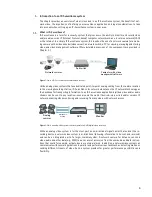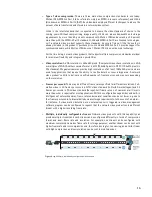
16
>
Audio support
: A network camera with audio support comes either with a built-in microphone or
an input for an external microphone. Speakers may be built in or external. An audio feature
enables users to remotely listen in on an area and communicate instructions, orders or requests to
visitors or intruders. Audio can also be used as an independent detection method. When sound
above a certain level is detected, video recordings and alarms can be triggered.
Figure 2.1.q.
Enhancing video surveillance with audio
Audio modes may be simplex (audio is sent either by the operator or the camera), half duplex
(audio is sent in both directions, but only one party at a time can send) or full duplex (audio is sent
to and from the operator simultaneously). Audio can be compressed and integrated into the video
stream, and sent over a network for monitoring and/or recording. There are four audio compres-
sion standards used in network video. They are AAC-LC, which requires a license, and G.711, G.726
and G.722.2 (Adaptive Multi-Rate—Wideband), which are non-licensed technologies. Audio and
video are two separate packet streams that are sent over a network. In order for the client or
player to perfectly synchronize the audio and video streams, the audio and video packets must be
time-stamped. Time stamping using Motion JPEG may not always be supported in a network
camera. If synchronized audio and video is a priority, it is better to use H.264 or MPEG-4 Part 2
for the video compression since time stamping is usually supported using those standards.
>
Input and output (I/O) ports
: Input/output connectors enable external devices to be connected
to a network camera. Inputs to a camera (e.g. a door contact, infrared motion detector, glass break
sensor or shock sensor) enable the camera to react to an external event by, for example, initiating
the sending and recording of video. Outputs enable the camera to control external devices such as
activating alarms, triggering door locks, generating smoke or turning on lights.
I/Os also allow you to save storage space. For example, if you want to simply capture the identity
of a person at an entrance, you do not need the camera to continually send video. You can set up
the system in such a way that the camera is triggered to capture and send the necessary image
frames only when the door opens. I/O ports are available in all Axis network cameras and video
encoders.
>
Video motion detection
: Video motion detection monitors changes in the camera’s field of view
and if a change occurs (e.g. an intruder enters the scene), an alarm condition is generated. This
function can be a built-in feature of a network camera or a feature of a video management soft-
ware. Using the built-in video motion detection feature in a network camera reduces bandwidth
use since no video is delivered on the network unless video motion is detected. Video motion
detection is a standard feature in all Axis network cameras.
>
Active tampering alarm
: This is an intelligent video analytics application available in selected
Axis network video products. When a camera is manipulated in any way (e.g. accidental redirec-
tion, blocking, defocusing spray-painted, covered or damaged), it can automatically trigger
recordings and alert notifications.
Axis network
camera
Power over Ethernet-
enabled network switch
Computer
Microphone
Microphone
Loudspeaker
Loudspeaker
Summary of Contents for IP-Surveillance system
Page 49: ...49 ...
















































